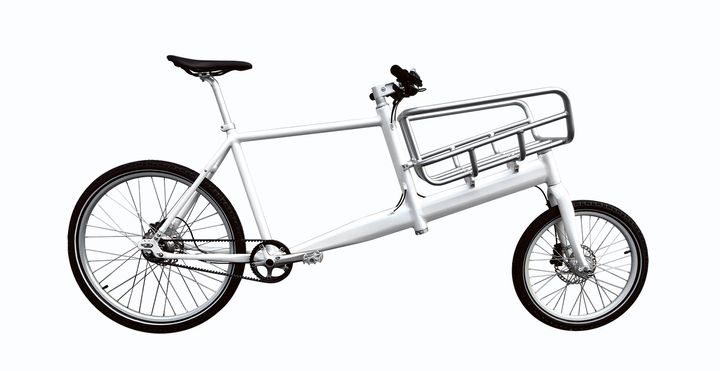
Biomega PEK bike
Co-authored by Ditte Lysgaard Vind, co-founder of Network for Circular Economy, and founder of The Circular Way.
We are in a situation where our global population is continuously growing, and at the same time we need to lower our emissions to avoid a fatal rise in temperatures, we need to address how we actually get there: Design is key.
Imagine shoes made of plastic waste and yarn picked up from the Earth's oceans; T-shirts made from recycled polyester; Houses built of old newspapers and champagne corks; And products such as lamps and baby clothes that create value for many customers through services instead of being sold to one individual consumer and eventually discarded.
These are just a few examples of how our consumption patterns are changing. A necessary transformation, and a solution to the challenge of the globe’s rapidly growing population that consumes and depletes it’s dwindling resources.
Perhaps you noticed that H&M, Nike and Adidas announced their intentions to adapt their businesses to the circular economy. And perhaps that made you start wonder what on earth circular economy really is? Why would it be a great idea for brands, societies and consumers alike? And how is design an essential catalyst for a future in which waste is replaced by sustainable aesthetics, quality and growth?
Designers creative ability to think across traditional materials, methods, sectors and professions – and produce attractive products – can deliver impactful global change. It is not only a question of streamlining existing products or creating sustainable additional benefits. Rather, it’s about redesigning products and business models from the bottom so that growth and consumption in households, companies and societies can go on, without including the usage of new resources or materials, and without compromising aesthetics or quality. As such, established brands and startups have equally much to gain from the circular economy. Mainly the ability to create the products and the future we need. That is the real end game of the circular economy. The task is obviously not easy, and requires new types of skills - and design.
Old wine in new bottles?
Circular economy essentially decouples growth from the use of new resources and materials by extending the life-cycle of resources in use and bringing them into circulation. One might think that this is simply old wine in new bottles – nothing but a new fancy word for recycling. That is not the case: The core of circular economy is that the product or material is designed to create value by its circulation. The Ellen Macarthur Foundation puts it this way: "A circular economy is restorative and regenerative by design, and seeks keep products, components, and materials at its highest utility and value at all times."
Take apparel as an example: Reselling it via online platforms and thrift stores are usual ways to prolong the lifecycle. But it’s also a just a type of damage control – we squeeze the most out of a product flawed by design. Until we begin designing clothes of lasting quality from the get go, we are not really changing much. In a real circular model, products are made to last as long as possible, in a way that makes it possible to separate and re-use the different materials again and again. The good news is that more and more companies are adopting such a circular business model. In this model, consumers subscribe to and lease their products rather than buy and sell them.
Thus, it is no longer about producing and selling many products as possible - but instead to produce the best possible quality, so that the product can be kept in circulation and rented out as long as possible.
If you one day find yourself in Schiphol Airport in Amsterdam, you might have the opportunity to experience this model yourself. The Dutch airport no longer buys lamps and bulbs to light up the many gates, terminals and shops inside – they lease energy-efficient lighting systems as a service from Philips. They now have a completely different incentive to design durable products that can be reused as they are dismantled, or so each part of the product gets a new product life-cycle.
Why is it a good idea?
With a steadily growing global middle class and an increasing global population, the earth will be housing 9.7 billion people by the year of 2050. As a natural consequence, the demand for everyday consumer goods, housing and transportation will rise exponentially – requiring material resources we simply do not have. At the same time, we are already facing enormous climatic and environmental challenges that will aggravate if we continue to produce and consume as we do. Should future generations and developing countries pay the high price for our mistakes? It may not be necessary.
We need to fundamentally revisit our consumption and production patterns - and to move from a linear to a circular economy. We need to adopt an economic system where resources and products are put into circulation rather than thrown out and wasted. Imagine, for example, a house built of champagne corks, old newspapers and other recycled products. It sounds strange, if not impossible. Nevertheless, such a house has been built in the Danish city of Nyborg, without compromising aesthetics, price or quality. The possibilities are too many to list. An analysis by the Ellen Macarthur Foundation and McKinsey & Company, suggests that by minimizing the materials used for consumer goods, we will be able to save no less than 700 billion dollars globally.
The circular economy helps us solve many global challenges, as outlined at the COP21 in Paris and the United Nations’ new sustainable development goals, but this is not just about doing good. If we succeed to innovate and transform our economy to be circular - and thus scalable - there will are massive economic gains to be had.
We can design the future we need to ensure good sustainable products for everyone without compromising quality, cost or aesthetics. We can mitigate climate change while catering to global demand by decoupling growth from material consumption - and make a ton of money doing it.
